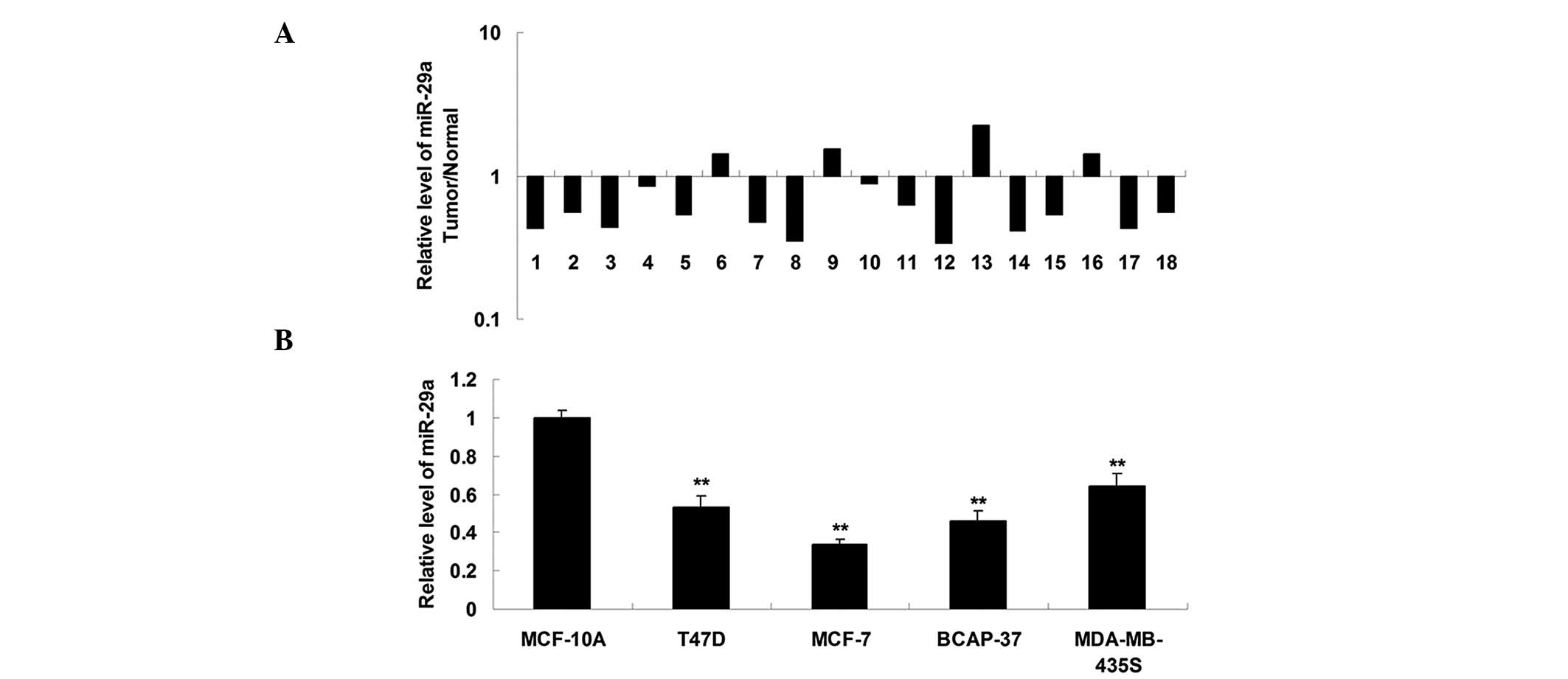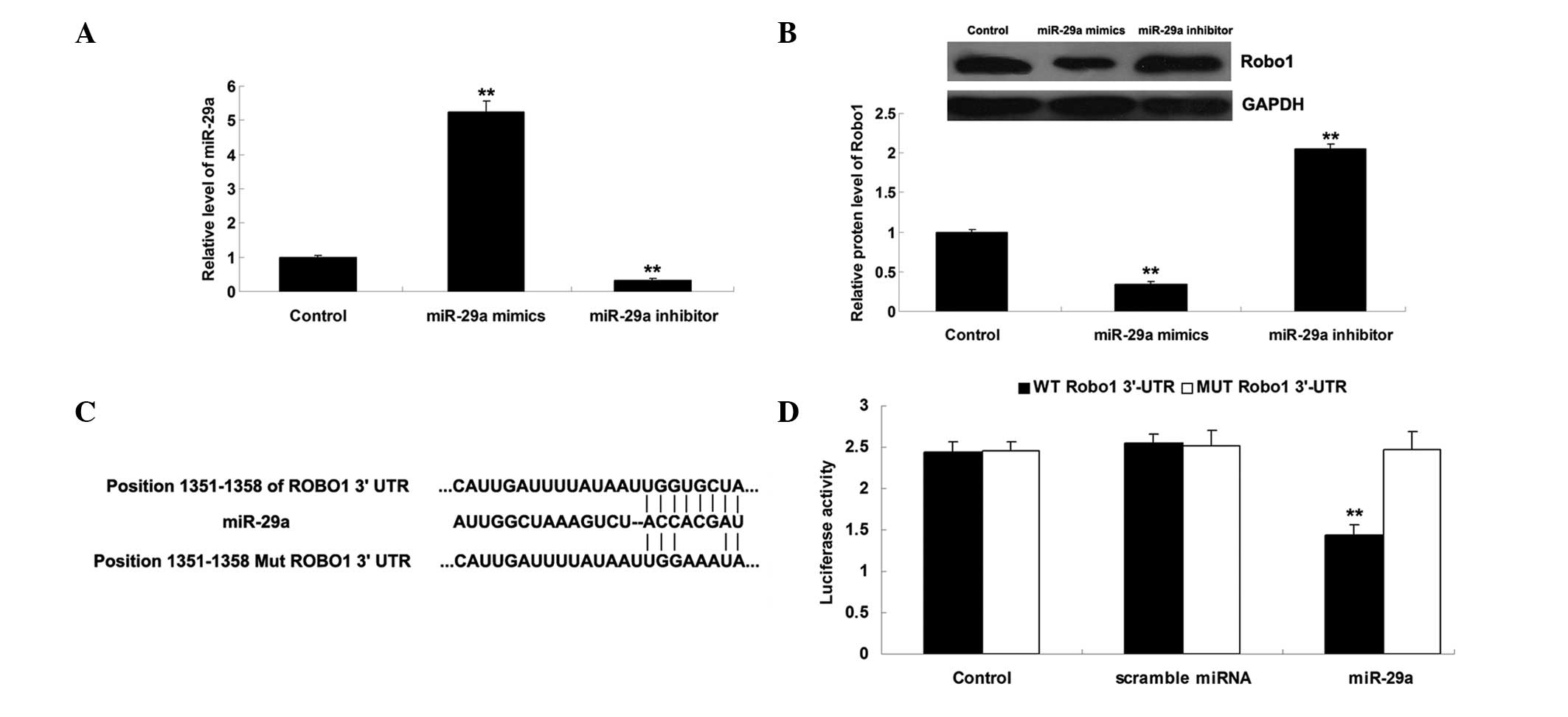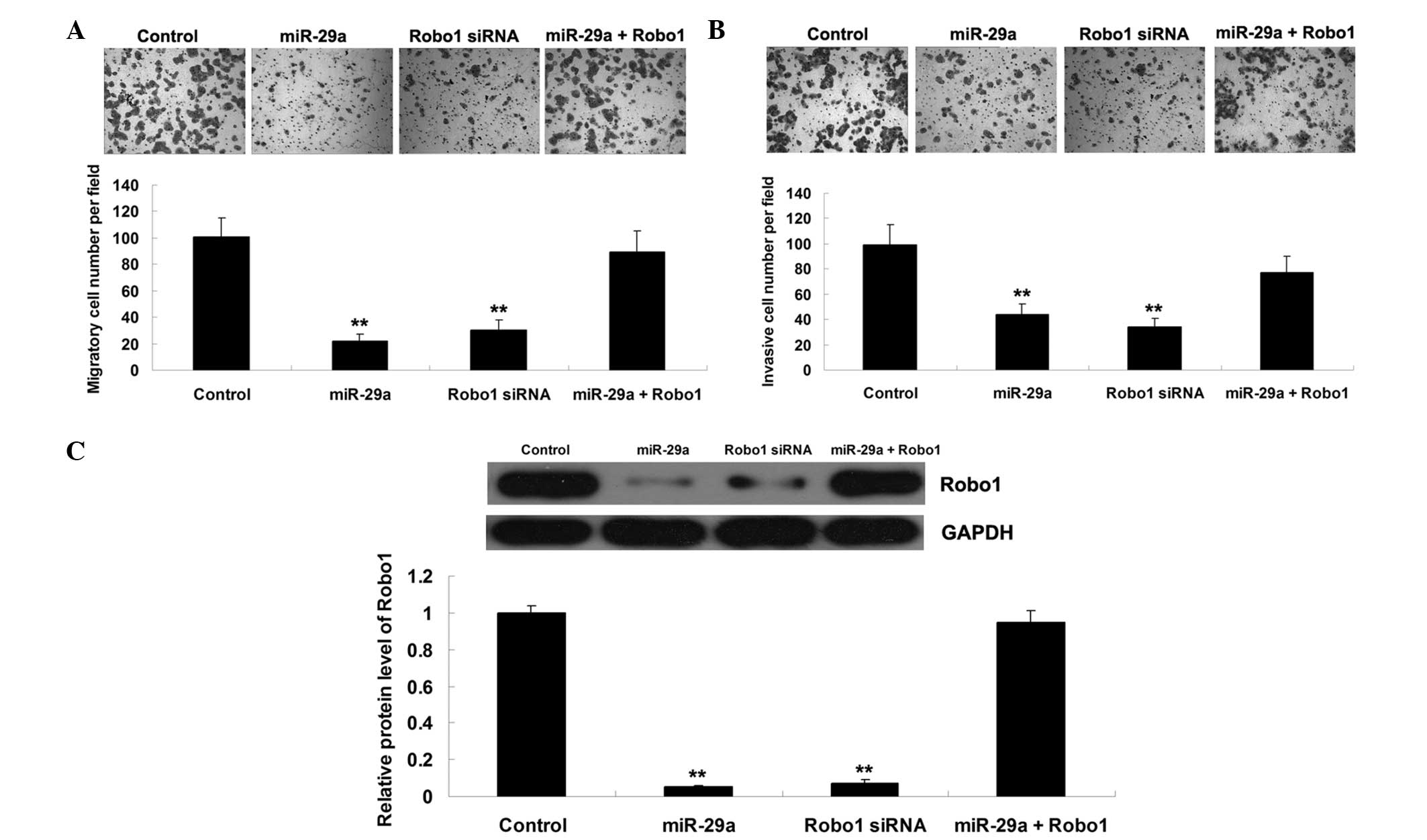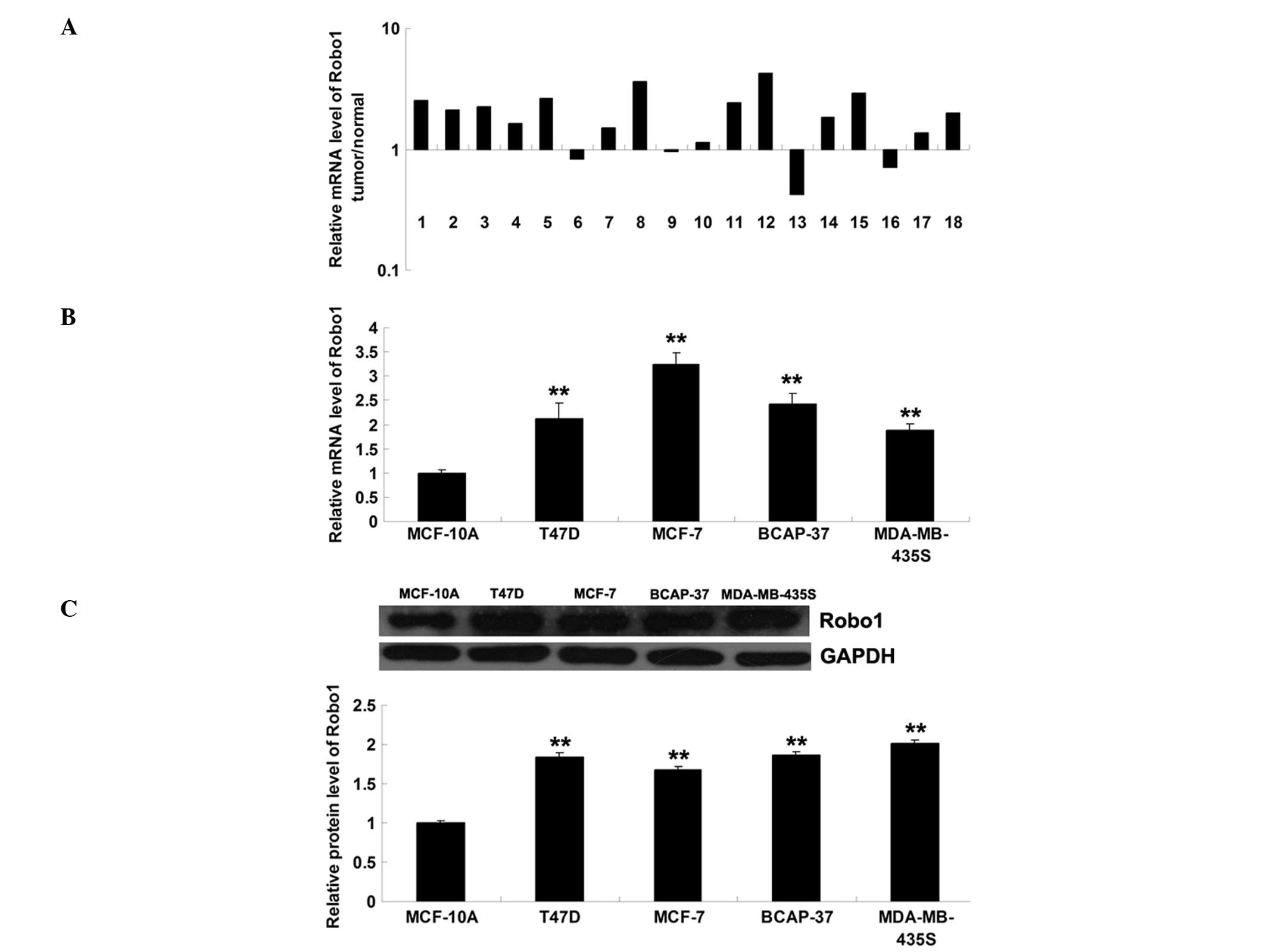MicroRNA‑29a inhibits cell migration and invasion by targeting Roundabout 1 in breast cancer cells
Retraction in: /10.3892/mmr.2023.13151
- Authors:
- Published online on: May 7, 2015 https://doi.org/10.3892/mmr.2015.3749
- Pages: 3121-3126
Abstract
Introduction
Breast cancer is a common malignant tumor in females, accounting for a high proportion of cancer-associated mortality (1). However, the molecular mechanisms underlying breast cancer remain to be elucidated. The identification of potential molecular targets for the treatment of breast cancer appears promising (2).
MicroRNAs (miRNAs) are a class of short (~20 nt) non-coding RNAs, which bind to the 3′-untranslated region (UTR) of their target mRNAs, and exert a suppressive effect on protein translation or induce degradation of the mRNA (3). By negatively regulating the protein expression of their targets, miRNAs influence various biological processes, including cell survival, proliferation, differentiation and motility (4–6). The deregulation of miRNAs has been demonstrated to be associated with the development and progression of multiple types of human malignancy, including breast cancer, indicating that these molecules act as tumor suppressors or oncogenes (7,8). Among the miRNAs investigated, miR-29a has been shown to act as a tumor suppressor in several types of human cancer, including prostate cancer, colorectal cancer, oral squamous carcinoma and breast cancer (9–12). Wu et al reported that miR-29a exerted an inhibitory effect on breast cancer cell growth (9). However, the precise function of miR-29a in the regulation of cell migration and invasion in breast cancer cells, and the mechanisms underlying its effects on these processes remain to be elucidated.
The secreted Slit glycoproteins and their Roundabout (Robo) receptors were originally identified as important axon guidance molecules (13,14). Robo1 is a member of Robo family, which is expressed in multiple cell types and is important in the regulation of various biological processes, including cell proliferation, differentiation and migration (15–17). A previous study demonstrated the involvement of Robo1 in cancer cell migration and invasion (18). In addition, a bioinformatic analysis suggested that Robo1 is a putative target of miR-29a (19). However, the underlying mechanisms by which Robo1 mediates breast cancer remain to be elucidated.
The present study primarily aimed to investigate the effects of miR-29a and Robo1 on the regulation of cell migration and invasion in breast cancer cells. The mechanisms underlying these effects were also examined.
Materials and methods
Tissue specimen collection
The present study was approved by the Ethical Committee of Jishou University (Jishou, China). Breast cancer tissues and matched adjacent normal tissues (n=18) were obtained from the Department of General Surgery, People’s Hospital of Xiangxi Autonomous Prefecture, Jishou University (Jishou, China). Written informed consent was obtained from patients with breast cancer. The tissue samples were frozen in liquid nitrogen following surgery, until use.
Cell culture
T47D, MCF-7, BCAP-37 and MDA-MB-435S human breast cancer cell lines, and the MCF-10A normal breast epithelial cell line, were purchased from ScienCell (San Diego, CA, USA). All cells were cultured in Dulbecco’s modified Eagle’s medium (DMEM; Life Technologies, Carlsbad, CA, USA), supplemented with 10% fetal bovine serum (FBS; Life Technologies) at 37°C with 5% CO2.
Reverse transcription-quantitative polymerase chain reaction (RT-qPCR)
Total RNA was isolated using TRIzol reagent (Invitrogen Life Technologies, Carlsbad, CA, USA), according to the manufacturer’s instructions. For miRNA detection, total RNA was reverse transcribed using the miScript Reverse Transcription kit (Qiagen, Valencia, CA, USA), according to the manufacturer’s instructions. RT-qPCR of the miRNA was then performed using the miScript SYBR Green PCR kit (Qiagen) on an ABI7500 PCR machine (Invitrogen Life Technologies). RT-qPCR was conducted at 95°C for 15 min, followed by 40 cycles of 94°C for 15 sec, 55°C for 30 sec and 70°C for 30 sec. The relative expression of miRNA was normalized against that of U6. For mRNA detection, the total RNA was reverse transcribed into cDNA using the RevertAid First-Strand cDNA Synthesis kit (Fermentas, Carlsbad, CA, USA), according to the manufacturer’s instructions. RT-qPCR was subsequently performed using iQTM SYBR Green Supermix (Bio-Rad, Hercules, CA, USA) by denaturation at 95°C for 15 min, followed by 40 cycles of 94°C for 15 sec, 55°C for 30 sec and 70°C for 30 sec. The specific primers used were as follows: Forward: 5′-GGCGGTGAAGGAGATGAAC-3′ and reverse: 5′-TGATGAGGAAATCCACGATAGAG-3′ for Robo1 and forward: 5′-ACAACTTTGGTATCGTGGAAGG-3′ and reverse: 5′-GCCATCACGCCACAGTTTC-3′ for GAPDH. The relative mRNA expression of Robo1 was normalized against that of GAPDH.
Western blot assay
Cells were lysed in radioimmunoprecipitation buffer (Sigma-Aldrich, St. Louis, MO, USA). The total protein was isolated and the concentration was determined using the bicinchoninic acid protein assay kit (Santa Cruz Biotechnology, Inc., Santa Cruz, CA, USA). For western blot analysis, equal quantities of protein were boiled and separated using 10% SDS-PAGE gels (Sigma-Aldrich), and blotted onto polyvinylidene difluoride (PVDF) membrane (Life Technologies), which was blocked with 5% non-fat dried milk in phosphate-buffered saline (PBS) for 1.5 h at room temperature. The PVDF membrane was subsequently incubated with rabbit polyclonal anti-Robo1 (1:50; cat. no. ab7279) or rabbit polyclonal anti-GAPDH (1:50; cat. no. ab181602) antibodies (Abcam, Cambridge, MA, USA) at room temperature for 3 h. The membranes were washed with PBS, and were then incubated with goat anti-rabbit immunoglobulin G H&L secondary antibody (1:5,000; cat. no. ab175773; Abcam) for 40 min at room temperature. Chemiluminescent detection was performed using an enhanced chemiluminescence kit (Pierce Biotechnology, Inc., Rockford, IL, USA).
Transfection
Transfections were performed using lipofectamine 2000 (Invitrogen Life Technologies), according to the manufacturer’s instructions. For miR-29a functional analysis, the cells were transfected with scrambled miRNA as a negative control (NC), miR-29a mimics or an miR-29a inhibitor (Invitrogen Life Technologies). For Robo1 functional analysis, the cells were transfected with Robo1-specific small interfering RNA (siRNA) or Robo1 plasmid (Nlunbio, Changsha, China).
Luciferase reporter assay
A luciferase reporter assay was performed in MCF-7 human breast cancer cells. The wild-type (WT) 3′-UTR of Robo1 mRNA or the mutant type (MUT) 3′-UTR of Robo1 mRNA were inserted downstream of the luciferase reporter gene in the pMIR-REPORT vector (Life Technologies). Subsequently, cells were cotransfected with miR-29a mimics or scrambled miRNA; pMIR-REPORT vectors containing the WT or MUT Robo1 3′-UTR; and pRL-SV40 (Promega Corporation, Sunnyvale, CA, USA), expressing Renilla luciferase. The cells were cultured for 48 h following transfection and the luciferase activities were measured using the Dual-Luciferase Reporter assay system (Promega Corporation).
Cell migration and invasion assay
Cell migration and invasion assays were performed using transwell chambers (BD Bioscience, Franklin Lakes, NJ, USA). Cell suspension, containing 5×105 cells/ml, was prepared in serum-free media. For cell migration assays, 300 μl cell suspension was added into the upper chamber of the transwells. For cell invasion assays, 300 μl cells were added into the upper chamber of transwells that were pre-coated with matrigel (BD Bioscience). DMEM (500 μl), containing 10% FBS as a chemo-attractant, was added into the lower chamber of the transwell. The cells were incubated for 24 h and cells, which failed to migrate or invade through the pores were carefully removed using a cotton-tipped swab. The filters were fixed in 90% alcohol and stained using crystal violet (Sigma-Aldrich). Cell numbers were determined in five randomly-selected fields under an inverted microscope (TS100; Nikon Corporatino, Tokyo, Japan).
Statistical analysis
The data are expressed as the mean ± standard deviation of three independent experiments. SPSS 17.0 statistical software (SPSS, Inc., Chicago, IL, USA) was used to analyze the differences between the groups using one-way analysis of variance. P<0.05 was considered to indicate a statistically significant difference.
Results
miR-29a is downregulated in breast cancer tissues and cells
The expression of miR-29a was determined using RT-qPCR in breast cancer tissues and matched normal adjacent tissues. As shown in Fig. 1A, the expression of miR-29a in breast cancer tissues was markedly reduced compared with that in the normal adjacent tissues. The expression of miR-29a was determined in four breast cancer cell lines, including T47D, MCF-7, BCAP-37 and MDA-MB-435S, and in one normal breast epithelial cell line, MCF-10A. As shown in Fig. 1B, miR-29a was also downregulated in breast cancer cell lines compared with the MCF-10A cell line. These findings suggested that miR-29a is involved in breast cancer progression. MCF-7 cells exhibited the greatest downregulation in the expression of miR-29a (Fig. 1B) and were therefore used for subsequent analysis.
miR-29a negatively regulates the protein expression of its target, Robo1, in MCF-7 cells
The effect of miR-29a on the regulation of the expression of Robo1 was assessed in MCF-7 breast cancer cells. Following transfection with miR-29a mimics and an miR-29a inhibitor, the expression of miR-29a in MCF-7 cells was measured. As shown in Fig. 2A, transfection with miR-29a mimics caused an increase in the expression of miR-29a, while transfection with an miR-29a inhibitor led to downregulation of miR-29a, indicating that the transfection was successful. Subsequently, western blot analysis was performed to determine the protein expression levels of Robo1 in each group. As shown in Fig. 2B, upregulation of miR-29a led to a reduction in the expression of the Robo1 protein, whereas downregulation of miR-29a resulted in an increase in the expression of the Robo1 protein, indicating that the expression of Robo1 is negatively regulated by miR-29a in MCF-7 breast cancer cells. A luciferase reporter assay was conducted in order to confirm whether miR-29a directly binds to the 3′ UTR of Robo1 mRNA. As shown in Fig. 2C, a wild-type (WT-Robo1) and a mutant (MUT-Robo1) type of the Robo1 3′ UTR was generated. MCF-7 cells were cotransfected with the WT-Robo1 vector or the MUT-Robo1 vector, and the miR-29a mimics or a scrambled RNA. As demonstrated in Fig. 2D, the luciferase activity was significantly reduced compared with the control group, only in MCF-7 cells cotransfected with the WT-Robo1 vector and the miR-29a mimics. This repressive effect was abrogated in MCF-7 cells cotransfected with the MUT-Robo1 vector or the miR-29a mimics. These results suggested that miR-29a inhibits expression of the Robo1 protein via an interaction with the 3′-UTR of Robo1.
miR-29a suppresses cell migration and invasion by targeting Robo1 in MCF-7 cells
The functions of miR-29a and Robo1, and their association in the regulation of cell migration and invasion were further assessed in MCF-7 breast cancer cells. MCF-7 cells were transfected with miR-29a mimics or Robo1-specific siRNA, or cotransfected with miR-29a mimics and Robo1 plasmid. As shown in Fig. 3A and B, upregulation of miR-29a or downregulation of Robo1 significantly suppressed MCF-7 cell migration and invasion. However, the suppressive effects of miR-29a upregulation on MCF-7 cell migration and invasion were abrogated by overexpression of Robo1. Furthermore, western blotting was performed to determine the protein expression level of Robo1 in each group. As shown in Fig. 3C, the protein expression level of Robo1 was associated with the migratory and invasive capacities of MCF-7 cells in each group. These data suggested that miR-29a exerts a suppressive role in the regulation of cell migration and invasion, at least in part, through the direct inhibition of Robo1 expression in breast cancer cells.
Expression of Robo1 is increased in breast cancer tissues and cells
The level of Robo1 mRNA was subsequently determined in breast cancer tissues and matched normal adjacent tissues, using RT-qPCR. As shown in Fig. 4A, the mRNA level of Robo1 was significantly increased in breast cancer tissues compared with the normal adjacent tissues. In addition, the mRNA and protein expression levels of Robo1 were assessed in the T47D, MCF-7, BCAP-37 and MDA-MB-435S breast cancer cell lines, and in MCF-10A normal breast epithelial cells. As shown in Fig. 4B and C, Robo1 was upregulated in these four breast cancer cell lines compared with MCF-10A cells.
Discussion
Deregulation of miRNAs has been demonstrated to be involved in the progression of breast cancer (20). In the present study, the expression level of miR-29a was shown to be significantly reduced in breast cancer tissues and cell lines. Additionally, Robo1 was identified as a novel target of miR-29a and its expression level was markedly upregulated in breast cancer tissues and cell lines. It was shown that the protein expression of Robo1 was negatively regulated by miR-29a and that miR-29a suppressed cell migration and invasion, at least in part, by directly targeting Robo1 in MCF-7 breast cancer cells.
Deregulation of miR-29a has been shown to contribute to multiple types of human malignancy. Yu et al (21) reported that downregulation of miR-29a contributes to cisplatin resistance in ovarian cancer cells. Zhao et al (22) demonstrated that miR-29a inhibited glioma tumor growth and invasion by targeting heat shock protein 47. The present study demonstrated that miR-29a was significantly downregulated in breast cancer tissues compared with normal adjacent tissues. In addition, the expression level of miR-29a was also reduced in breast cancer cell lines compared with normal MCF-10A breast epithelial cells. miR-29a has been previously reported to be upregulated in serum, but downregulated in breast milk, in patients with breast cancer (23,24). Furthermore, Wu et al (9) suggested an inhibitory role of miR-29a in breast cancer cells. The authors demonstrated that the overexpression of miR-29a significantly suppressed breast cancer cell proliferation and led to a higher percentage of cells in G0/G1 phase. In addition, the novel target, B-Myb, an important transcription factor associated with tumorigenesis, was identified (9). The present study revealed that miR-29a exerts an inhibitory function in the regulation of cell migration and invasion of MCF-7 breast cancer cells. Based on previous studies and the results of the present study, it is hypothesized that miR-29a acts as a key tumor suppressor in breast cancer.
Since a single miRNA may have different targets in different cancer cells, the present study aimed to identify a novel target that is involved in the progression of breast cancer. Robo1 was identified as a target of miR-29a in MCF-7 breast cancer cells. Robo1 was shown to be involved in tumorigenesis and the expression of Robo1 is known to be increased in several types of cancer (25). Alajez et al (26) demonstrated that Robo1 was upregulated in nasopharyngeal carcinoma, and its overexpression was significantly associated with a reduced level of overall and nodal relapse-free survival. In addition, Robo1 was also shown to be regulated by Src and Abl, and to promote tumor cell migration (27). Previously, Robo1 was shown to be involved in the regulation of cell migration and invasion in breast cancer cells (28). Yang et al (28) demonstrated that as one of the receptors for Slit, Robo1 is involved in miR-218-mediated inhibition of migration and invasion in breast cancer cells. The present study demonstrated a similar molecular mechanism, in which miR-29a inhibited cell migration and invasion by directly inhibiting the protein expression of Robo1 in breast cancer cells. Therefore, Robo1 is a common target for miR-29a and miR-218, each of which exert similar inhibitory effect on breast cancer cell migration and invasion. In addition, the oncogenic role of Robo1 in the regulation of cancer cell migration and invasion has been reported in other types of cancer. For instance, Tie et al (29) reported that Robo1 was negatively regulated by miR-218, and that this promoted the invasion and metastasis of gastric cancer (29).
In conclusion, the present study identified Robo1 as a direct target of miR-29a, and suggested that miR-29a exerts an inhibitory function in the regulation of cell migration and invasion, at least in part by suppressing the protein expression levels of Robo1 in breast cancer cells. Therefore, the results of the present study suggest that miR-29a and Robo1 may serve as potential targets for the treatment of metastatic breast cancer.
References
|
Murawa P, Murawa D, Adamczyk B and Polom K: Breast cancer: Actual methods of treatment and future trends. Rep Pract Oncol Radiother. 19:165–172. 2014. View Article : Google Scholar : PubMed/NCBI | |
|
Serpico D, Molino L and Di Cosimo S: microRNAs in breast cancer development and treatment. Cancer Treat Rev. 40:595–604. 2014. View Article : Google Scholar | |
|
Brower J, Clark PA, Lyon W and Kuo JS: MicroRNAs in cancer: Glioblastoma and glioblastoma cancer stem cells. Neurochem Int. 77:68–77. 2014. View Article : Google Scholar : PubMed/NCBI | |
|
Ishiguro H, Kimura M and Takeyama H: Role of microRNAs in gastric cancer. World J Gastroenterol. 20:5694–5699. 2014. View Article : Google Scholar : PubMed/NCBI | |
|
Bouyssou JM, Manier S, Huynh D, Issa S, Roccaro AM and Ghobrial IM: Regulation of microRNAs in cancer metastasis. Biochim Biophys Acta. 1845:255–265. 2014.PubMed/NCBI | |
|
Kotaja N: MicroRNAs and spermatogenesis. Fertil Steril. 101:1552–1562. 2014. View Article : Google Scholar : PubMed/NCBI | |
|
Shah NR and Chen H: MicroRNAs in pathogenesis of breast cancer: Implications in diagnosis and treatment. World J Clin Oncol. 5:48–60. 2014. View Article : Google Scholar : PubMed/NCBI | |
|
Zhu J, Zheng Z, Wang J, et al: Different miRNA expression profiles between human breast cancer tumors and serum. Front Genet. 5:1492014. View Article : Google Scholar : PubMed/NCBI | |
|
Wu Z, Huang X, Zou Q and Guo Y: The inhibitory role of Mir-29 in growth of breast cancer cells. J Exp Clin Cancer Res. 32:982013. View Article : Google Scholar : PubMed/NCBI | |
|
Nishikawa R, Goto Y, Kojima S, et al: Tumor-suppressive microRNA-29 s inhibit cancer cell migration and invasion via targeting LAMC1 in prostate cancer. Int J Oncol. 45:401–410. 2014.PubMed/NCBI | |
|
Yang Y, Gu X, Zhou M, Xiang J and Chen Z: Serum microRNAs: A new diagnostic method for colorectal cancer. Biomed Rep. 1:495–498. 2013. | |
|
Lu L, Xue X, Lan J, et al: MicroRNA-29a upregulates MMP2 in oral squamous cell carcinoma to promote cancer invasion and anti-apoptosis. Biomed Pharmacother. 68:13–19. 2014. View Article : Google Scholar | |
|
Chaturvedi S and Robinson LA: Slit2-Robo signaling in inflammation and kidney injury. Pediatr Nephrol. 30:561–566. 2015. View Article : Google Scholar | |
|
Yang YH, Manning Fox JE, Zhang KL, MacDonald PE and Johnson JD: Intraislet SLIT-ROBO signaling is required for beta-cell survival and potentiates insulin secretion. Proc Natl Acad Sci USA. 110:16480–16485. 2013. View Article : Google Scholar : PubMed/NCBI | |
|
Yuen DA and Robinson LA: Slit2-Robo signaling: a novel regulator of vascular injury. Curr Opin Nephrol Hypertens. 22:445–451. 2013. View Article : Google Scholar : PubMed/NCBI | |
|
Cornide-Petronio ME and Barreiro-Iglesias A: Role of Slit and Robo proteins in the development of dopaminergic neurons. Dev Neurosci. 35:285–292. 2013. View Article : Google Scholar : PubMed/NCBI | |
|
Dickinson RE and Duncan WC: The SLIT-ROBO pathway: a regulator of cell function with implications for the reproductive system. Reproduction. 139:697–704. 2010. View Article : Google Scholar : PubMed/NCBI | |
|
Ballard MS and Hinck L: A roundabout way to cancer. Adv Cancer Res. 114:187–235. 2012.PubMed/NCBI | |
|
Lewis BP, Burge CB and Bartel DP: Conserved seed pairing, often flanked by adenosines, indicates that thousands of human genes are microRNA targets. Cell. 120:15–20. 2005. View Article : Google Scholar : PubMed/NCBI | |
|
Zhong L, Zhu K, Jin N, et al: A systematic analysis of miRNA-mRNA paired variations reveals widespread miRNA misregulation in breast cancer. Biomed Res Int. 2014:2912802014. View Article : Google Scholar : PubMed/NCBI | |
|
Yu PN, Yan MD, Lai HC, et al: Downregulation of miR-29 contributes to cisplatin resistance of ovarian cancer cells. Int J Cancer. 134:542–551. 2014. View Article : Google Scholar | |
|
Zhao D, Jiang X, Yao C, et al: Heat shock protein 47 regulated by miR-29a to enhance glioma tumor growth and invasion. J Neurooncol. 118:39–47. 2014. View Article : Google Scholar : PubMed/NCBI | |
|
Wu Q, Wang C, Lu Z, Guo L and Ge Q: Analysis of serum genome-wide microRNAs for breast cancer detection. Clin Chim Acta. 413:1058–1065. 2012. View Article : Google Scholar : PubMed/NCBI | |
|
Gu YQ, Gong G, Xu ZL, et al: miRNA profiling reveals a potential role of milk stasis in breast carcinogenesis. Int J Mol Med. 33:1243–1249. 2014.PubMed/NCBI | |
|
Dontula R, Dinasarapu A, Chetty C, et al: MicroRNA 203 modulates glioma cell migration via Robo1/ERK/MMP-9 signaling. Genes Cancer. 4:285–296. 2013. View Article : Google Scholar : PubMed/NCBI | |
|
Alajez NM, Lenarduzzi M, Ito E, et al: MiR-218 suppresses nasopharyngeal cancer progression through downregulation of survivin and the SLIT2-ROBO1 pathway. Cancer Res. 71:2381–2391. 2011. View Article : Google Scholar : PubMed/NCBI | |
|
Khusial PR, Vadla B, Krishnan H, et al: Src activates Abl to augment Robo1 expression in order to promote tumor cell migration. Oncotarget. 1:198–209. 2010. | |
|
Yang L, Li Q, Wang Q, Jiang Z and Zhang L: Silencing of miRNA-218 promotes migration and invasion of breast cancer via Slit2-Robo1 pathway. Biomed Pharmacother. 66:535–540. 2012. View Article : Google Scholar : PubMed/NCBI | |
|
Tie J, Pan Y, Zhao L, et al: MiR-218 inhibits invasion and metastasis of gastric cancer by targeting the Robo1 receptor. PLoS Genet. 6:e10008792010. View Article : Google Scholar : PubMed/NCBI |













